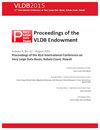AWS Glue的故事
IF 3.3
3区 计算机科学
Q2 COMPUTER SCIENCE, INFORMATION SYSTEMS
引用次数: 0
摘要
AWS Glue是亚马逊的无服务器数据集成云服务,它使提取、清理、丰富、加载和组织数据变得简单而经济高效。AWS Glue最初于2017年8月推出,最初是一种提取-转换-加载(ETL)服务,旨在减轻开发人员和数据工程师在Amazon S3上加载数据库、数据仓库和构建数据湖所需的繁重工作。从那时起,它已经发展到服务于包括ETL专家和数据科学家在内的更大的受众,并包括更广泛的数据集成功能套件。如今,每个月都有数十万客户使用AWS Glue。在本文中,我们描述了云客户在准备分析数据时面临的用例和挑战,以及我们选择的驱动Glue设计的原则。我们在早期选择将重点放在易用性、可扩展性和可扩展性上。Glue的核心是提供无服务器的Apache Spark和Python引擎,由专门构建的资源管理器支持,用于快速启动和自动扩展。在Spark中,它提供了一种新的数据结构——DynamicFrames——用于操作杂乱的无模式半结构化数据,如事件日志,各种转换和工具来简化数据准备,以及一个新的shuffle插件来卸载到云存储。它还包括一个与Hivemetastore兼容的数据目录和Glue爬虫来构建和管理元数据,例如Amazon S3上的数据湖。最后,Glue Studio是用于创建基于Spark和python的ETL作业的可视化界面。我们将介绍使AWS Glue与众不同并推动其流行的创新,以及多年来它是如何发展的。本文章由计算机程序翻译,如有差异,请以英文原文为准。
The Story of AWS Glue
AWS Glue is Amazon's serverless data integration cloud service that makes it simple and cost effective to extract, clean, enrich, load, and organize data. Originally launched in August 2017, AWS Glue began as an extract-transform-load (ETL) service designed to relieve developers and data engineers of the undifferentiated heavy lifting needed to load databases, data warehouses, and build data lakes on Amazon S3. Since then, it has evolved to serve a larger audience including ETL specialists and data scientists, and includes a broader suite of data integration capabilities. Today, hundreds of thousands of customers use AWS Glue every month. In this paper, we describe the use cases and challenges cloud customers face in preparing data for analytics and the tenets we chose to drive Glue's design. We chose early on to focus on ease-of-use, scale, and extensibility. At its core, Glue offers serverless Apache Spark and Python engines backed by a purpose-built resource manager for fast startup and auto-scaling. In Spark, it offers a new data structure --- DynamicFrames --- for manipulating messy schema-free semi-structured data such as event logs, a variety of transformations and tooling to simplify data preparation, and a new shuffle plugin to offload to cloud storage. It also includes a Hivemetastore compatible Data Catalog with Glue crawlers to build and manage metadata, e.g. for data lakes on Amazon S3. Finally, Glue Studio is its visual interface for authoring Spark and Python-based ETL jobs. We describe the innovations that differentiate AWS Glue and drive its popularity and how it has evolved over the years.
求助全文
通过发布文献求助,成功后即可免费获取论文全文。
去求助
来源期刊

Proceedings of the Vldb Endowment
Computer Science-General Computer Science
CiteScore
7.70
自引率
0.00%
发文量
95
期刊介绍:
The Proceedings of the VLDB (PVLDB) welcomes original research papers on a broad range of research topics related to all aspects of data management, where systems issues play a significant role, such as data management system technology and information management infrastructures, including their very large scale of experimentation, novel architectures, and demanding applications as well as their underpinning theory. The scope of a submission for PVLDB is also described by the subject areas given below. Moreover, the scope of PVLDB is restricted to scientific areas that are covered by the combined expertise on the submission’s topic of the journal’s editorial board. Finally, the submission’s contributions should build on work already published in data management outlets, e.g., PVLDB, VLDBJ, ACM SIGMOD, IEEE ICDE, EDBT, ACM TODS, IEEE TKDE, and go beyond a syntactic citation.
 求助内容:
求助内容: 应助结果提醒方式:
应助结果提醒方式:


